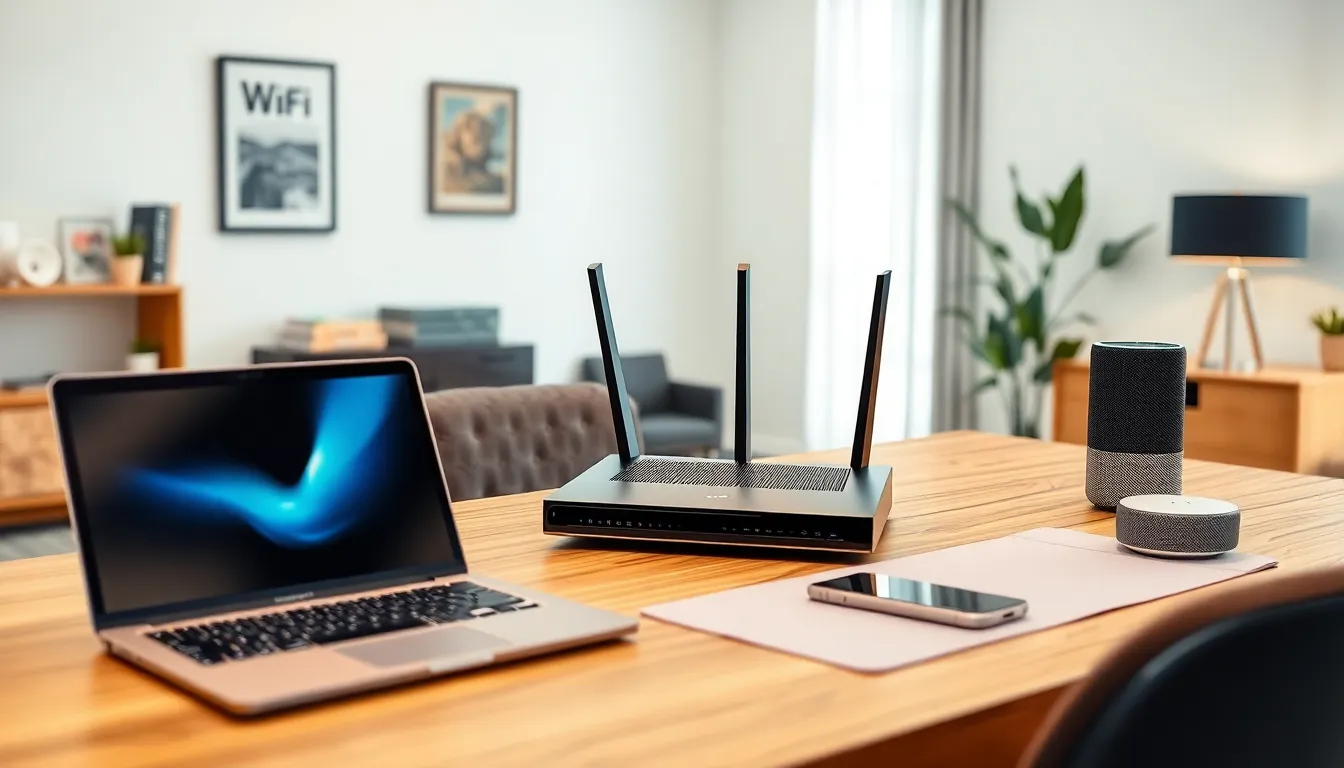In today’s digital age, a reliable home network is essential for seamless connectivity. With smart devices, streaming services, and remote work becoming the norm, upgrading a home network can significantly enhance performance and user experience.
Many homeowners underestimate the impact of a robust network, often settling for outdated equipment that can’t keep up with their needs. An upgrade not only boosts speed but also improves security and supports multiple devices without lag. Understanding the benefits and options available can empower anyone to make informed decisions that elevate their home connectivity.
Table of Contents
ToggleUnderstanding Home Network Upgrade
Upgrading a home network enhances performance and connectivity. Many factors contribute to the need for an upgrade, including increased internet speed requirements, growing numbers of devices, and security vulnerabilities.
Key Components of a Home Network Upgrade
- Router
Upgrading to a modern router improves signal strength and coverage. Routers with Wi-Fi 6 technology offer faster speeds and better performance in environments with multiple devices.
- Modem
A compatible modem ensures optimal internet speed from the Internet Service Provider (ISP). Newer modems support higher bandwidth tiers, accommodating advanced service plans.
- Switches
Installing network switches allows for more wired connections. This feature can reduce latency and provide stable connections for devices like gaming consoles and PCs.
- Access Points
Adding wireless access points expands coverage, eliminating dead zones. These devices enhance connectivity for remote areas within the home.
- Cabling
Using high-quality Ethernet cables improves data transmission speeds. Cat6 or Cat7 cables support bandwidths suitable for multiple devices, ensuring reliable connections.
Benefits of Upgrading a Home Network
- Increased Speed
Upgrades often result in faster browsing experiences, smoother streaming, and improved video conferencing quality.
- Enhanced Security
Modern equipment includes advanced security features like WPA3 and improved firmware updates. This protects against unauthorized access and malware threats.
- Better Device Management
Upgrades enable effective management of multiple devices on the network. Quality of Service (QoS) settings prioritize bandwidth for critical applications, ensuring optimal performance.
- Future-Proofing
Investing in an upgraded network prepares the home for future technology advancements. This approach accommodates emerging smart home devices and high-speed internet services.
Factors to Consider Before an Upgrade
- Current Usage
Assessing current usage patterns helps determine necessary upgrades. Identifying bandwidth-heavy applications can inform specific equipment needs.
- ISP Compatibility
Verifying compatibility with the ISP ensures that upgraded devices utilize available bandwidth. Choosing equipment that aligns with the current service plan maximizes performance.
- Budget
Setting a budget for the upgrade enables strategic equipment selection. Balancing cost with feature requirements ensures effective investment without overspending.
Benefits of Upgrading Your Home Network

Upgrading a home network brings multiple advantages, significantly enhancing overall connectivity and functionality. Key benefits include improved speed and performance, as well as enhanced security features.
Improved Speed and Performance
Upgrading network equipment boosts internet speed, enhancing browsing, streaming, and gaming experiences. Modern routers support higher data transfers, reducing latency during peak usage. With Wi-Fi 6 technology, devices can connect simultaneously without lag, allowing seamless streaming on multiple devices. For example, households with smart appliances and video streaming can benefit from uninterrupted connections. Improved bandwidth capacity with advanced modems and network switches supports high-demand scenarios, ensuring users can run essential applications smoothly.
Enhanced Security Features
Upgraded home networks incorporate advanced security protocols to protect against cyber threats. Features like WPA3 encryption enhance data protection, safeguarding sensitive information from intrusions. Modern routers come with built-in firewalls to block unauthorized access, while antivirus solutions protect connected devices. Enhanced security settings allow for better control over connected devices, reducing risks of hacks or data breaches. Additionally, parental controls enable monitoring of children’s internet usage, ensuring a safer online environment. Upgrading to higher security standards aligns with the increasing need for protection in a digitally connected world.
Key Components for Home Network Upgrade
Upgrading a home network involves key components that enhance performance and connectivity. These components ensure a reliable and efficient network suitable for a modern digital lifestyle.
Routers and Modems
Routers and modems form the backbone of a home network. Modern routers, especially those featuring Wi-Fi 6 technology, provide superior signal strength, increased data transfer rates, and improved capacity for multiple devices. These routers support faster internet speeds and lower latency, crucial for streaming and gaming.
Choosing a compatible modem is essential for optimal internet speeds. Latest standards, such as DOCSIS 3.1, increase upstream and downstream capacity while managing higher speeds from Internet Service Providers (ISPs). Together, a high-quality router and modem create a robust network capable of handling demanding tasks seamlessly.
Range Extenders and Access Points
Range extenders and wireless access points expand coverage throughout larger homes or areas with Wi-Fi dead zones. Range extenders amplify existing signals, improving connectivity in remote corners of the home. They are easy to install, enhancing the overall user experience without significant modifications to the network.
Wireless access points connect to the router via Ethernet cables and provide a dedicated Wi-Fi signal in different locations. They eliminate dead zones by creating strong, reliable connections, ensuring consistent performance for smart devices. Utilizing these components can significantly enhance a home’s network, improving connectivity and user satisfaction.
Steps to Successfully Upgrade Your Home Network
Upgrading a home network involves a few essential steps to ensure a seamless experience. Assessing the current setup and choosing the right equipment are key components of this process.
Assessing Your Current Setup
Evaluating the existing network setup is crucial. Identify the speed of the current internet connection using a speed test, checking for any discrepancies between the subscribed plan and actual performance. Examine existing devices such as routers, modems, and switches for compatibility and performance capabilities. Analyze coverage areas throughout the home, recognizing dead zones and weak signal spots. Understanding bandwidth usage patterns helps in identifying whether upgrades are necessary, revealing whether multiple devices strain the existing network’s performance.
Choosing the Right Equipment
Selecting appropriate equipment enhances network performance significantly. Consider modern routers that support Wi-Fi 6 technology for improved speed and capacity. Opt for modems that comply with DOCSIS 3.1 standards to maximize internet speeds without interruptions. Incorporate network switches for wired device connections, boosting reliability. Evaluate the need for wireless access points and range extenders to eliminate dead zones and extend coverage. When purchasing Ethernet cables, choose high-quality options to enhance data transmission speeds and network stability. Each component should align with current usage needs, ISP compatibility, and budget constraints to ensure an effective upgrade.
Common Issues and Troubleshooting
Home network upgrades can present various challenges. Identifying and resolving these issues ensures an optimal experience. Here are common problems and solutions:
- Slow Internet Speeds
Slow speeds often arise from outdated equipment. Restarting the modem and router might serve as an immediate fix. Upgrading to newer models that support Wi-Fi 6 significantly enhances speed. Checking for bandwidth-heavy applications running in the background helps identify issues.
- Network Connectivity Drops
Frequent disconnections might stem from weak signal strength. Positioning the router in a central location can improve coverage. Utilizing wireless access points mitigates dead zones. Ensuring firmware is up to date can also address connectivity problems.
- Incompatible Devices
Older devices may struggle with newer network technologies. Confirming device compatibility before upgrading network components ensures seamless integration. For devices lacking modern standards, consider purchasing replacements that support current protocols.
- Weak Wi-Fi Signal
Weak signals typically result from physical obstructions or interference from other electronic devices. Conducting a site survey helps identify optimal router placement. Installing antennas or using Wi-Fi extenders can improve coverage.
- Security Vulnerabilities
Upgraded networks often introduce new security concerns. Implementing WPA3 encryption and regularly updating passwords enhances security. Activating built-in firewall features on routers serves as an additional layer of defense.
- Overloaded Network
Multiple devices can strain a home network. Monitoring connected devices helps assess load. Implementing Quality of Service (QoS) settings prioritizes bandwidth for critical applications, ensuring consistent performance.
- Ethernet Issues
Poor Ethernet connections may stem from faulty cables or ports. Inspecting Ethernet cables for damage guarantees reliable connectivity. Testing different ports on the switch or router helps locate potential issues.
- Configuration Errors
Incorrect configurations might result in various connectivity issues. Utilizing setup wizards provided by modern routers simplifies the configuration process. Reviewing user manuals for specific models ensures accurate adjustments.
By addressing these common issues effectively, individuals can maintain a robust and reliable home network that meets their digital demands.
Upgrading a home network is essential for anyone looking to enhance their digital experience. With the growing reliance on smart devices and streaming services, a robust network ensures seamless connectivity and security. By investing in modern equipment and understanding individual needs, homeowners can significantly improve their online activities.
Addressing common issues and implementing the right solutions will lead to a more reliable network that meets current and future demands. A well-planned upgrade not only boosts performance but also protects against potential cyber threats. Embracing these changes paves the way for a smarter, faster, and more secure home network.





